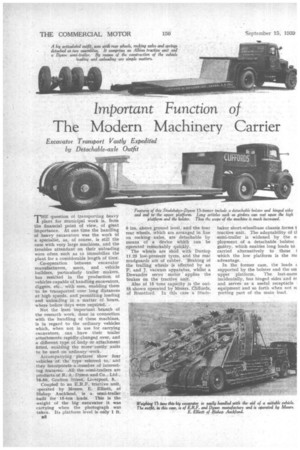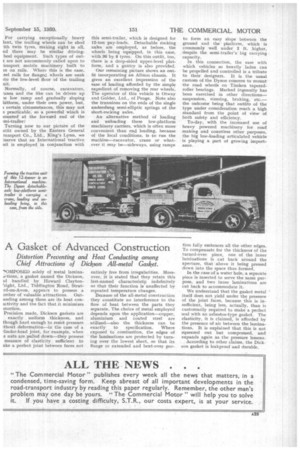important Function of The Modern Machinery Carrier
Page 34

Page 35

If you've noticed an error in this article please click here to report it so we can fix it.
T"question of transporting heavy plant for municipal work is, from the financial point of view, of great importance. At one time the handling of heavy excavators was the work of a specialist, as, of course, is still the case with very large machines, and the troubles attendant on their unloading were often such as to immobilize the plant for a considerable length of time.
Co-operation between excavator manufacturers, users, and vehicle builders, particularly trailer makers, has resulted in the production of vehicles capable of handling excavators, diggers, etc., with ease, enabling them to be transported over long distances at high speeds, and permitting loading and unloading in a matter of hours, where before days were required.
Not the least important branch of the research work, done in connection with the handling of these machines, is in regard to the ordinary vehicles which, when not in use for carrying excavators, can have their trailer attachments rapidly changed over, and a different type of body or attachment fitted, enabling the more costly units to be used on ordinary work.
Accompanying Pictures show four vehicles of the type referred to, and they incorporate a number of interesting features. All the semi-trailers are products: of R. A. Dyson and Co., Ltd., 76-80, Grafton Street, Liverpool, 8.
Coupled to an E.R.F. tractive unit, Iperated by Messrs. E. Elliott, of Bishop Auckland, is a semi-trailer built for 15-ton loads. This is the weight of the big excavator it was carrying when the photograph was taken. Its platform level is only 1 ft.
B8
9 ins, above ground level, and the four rear wheels, which are arranged in line on rocking axles, are detachable by means of a device which can be operated remarkably quickly.
The wheels are shod with Dunlop 11.25 low-pressure tyres, and the rear mudguards are of rubber. Braking of the trailing wheels is effected by an F. and J. vacuum apparatus, whilst a Dewandre servo motor applies the brakes on the tractive unit.
Also of 15 tons capacity is the outfit shown operated by Messrs. Cliffords, of 13rentford. In this case a Stude
baker short-wheelbase chassis forms t tractive unit. The adaptability of tl semi-trailer is widened by the e: ployment of a detachable bolster gantry, which enables long loads to carried alternatively to those i which the low platform is the ms advantage.
In the former case, the loads g supported by the bolster and the sin upper platform. The last-nanu incidentally, has hinged sides and ex and serves as a useful receptacle : equipment and so forth when not sr porting part of the main load. For carrying exceptionally heavy lant, the trailing wheels can be shod ith twin tyres, making eight in all ad there may be similar drivingheel equipment. Such types of outt are not uncommonly called upon to *ansport mobile machinery built to in on rails. Where this is the case, :eel rails for flanged wheels are sunk tto the low-level floor of the trailing nit.
Normally, of course, excavators, 7anes and the like can he driven up le low ramp and gradually sloping latform, under their own power, but, t certain circumstances, this may not e practicable; so a powerful winch is minted at the forward end of the
Turning now to our picture of the stilt owned by the Eastern General ransport Co., Ltd., King's Lynn, we Dserve that an International tractive it is employed in conjunction with
this semi-trailer, which is designed for 12-ton pay-loads. Detachable rocking axles are employed, as before, the wheels being equipped, in this case, with 36 by 8 tyres. On this outfit, too, there is a drop-sided upper-level platform, and a gantry is also provided.
Our remaining picture shows an outftt incorporating an Albion chassis. It gives an excellent impression of the ease of loading afforded by the simple expedient of removing the rear wheels. The operator of this vehicle is Otway and Golder, Ltd., of Penge. Note also the trunnions on the ends of the single underslung semi-elliptic springs of the short-rocking axles.
An alternative method of loading and unloading these low-platform machinery carriers, which is often more convenient than end loading, because of the local conditions, is to run the machine—excavator, crane or whatever it may be—sideways, using ramps to form an easy slope between the ground and the platform, which is commonly well under 2 ft. higher, despite the semi-trailer's big carrying capacity.
In this connection, the ease with which vehicles so heavily laden can be propelled and controlled is a tribute to their designers. It is the usual custom of the Dyson concern to mount the road wheels on Timken taperedroller bearings. Marked ingenuity has been exercised in other directions— suspension, steering, braking, etc— the outcome being that outfits of the type under consideration reach a high standard from the point of view of both safety and efficiency.
To-day, with the increased use of heavy powered machinery for road making and countless other purposes, the big low-loading articulated vehicle is playing a part of growing importance.




























































